- Membership Resources
- State Chapters
- Education/Events
-
Advocacy/Policy
- Home Care Workforce Crisis: An Industry Report and Call to Action
- Advocacy Fund
- State of Home Care: Industry at Crossroads
- Home Care Workforce Action Alliance
- Caring for Seniors: Value of Home Care
- Home Care by the Numbers
- Issues & Positions
- Legislative Action Network
- State Legislation Tracker
- Federal Legislation Tracker
- 2024 National Advocacy Day
- About HCAOA
- Find a Job
|
This webinar will help states by:
0 Comments
All providers are invited to participate in CMS’ Open Door Forum on Tuesday, July 30 at 2:00 p.m. for an overview of the home and community-based services (HCBS) provisions in the Ensuring Access to Medicaid Services Final Rule, including a deeper dive on what is commonly referred to as the “HCBS payment adequacy provision.”
Last week, the Georgia Department of Community Health (DCH) informed the HCAOA Georgia Chapter that it received approval from CMS for the Independent Care Waiver Program (ICWP) and Elderly and Disabled Waiver Program (EDWP) amendments submitted in May. The waiver amendments for both ICWP and EDWP were approved with an effective date of July 1, 2024.
Change Healthcare said it has begun notifying people who were impacted by the cyberattack on patient data in February. (press release)
As HCAOA has reported previously, several rate increases for Medicaid providers of home and community-based services (HCBS) in Georgia were included in the SFY 2025 budget, which was signed in May and later approved by the Georgia Department of Community Health. The increases were then sent to CMS for their approval prior to implementation. CMS has submitted a series of questions to DCH concerning these rate increases and responses have already been submitted. DCH continues to work closely with CMS to facilitate the final approval of the rate increases, and based on the current status, the goal continues to be an effective date of July 1.
CMS Projects Health Care Spending to Increase Over Next 10 Years, Outpacing Overall Spending6/19/2024 Between now and 2032, the average annual growth in health care spending will outpace overall spending, resulting in an increase in the health spending share of GDP from 17.3% in 2022 to 19.7% in 2032, according to an annual report released last week by the CMS Office of the Actuary. Personal health care price inflation and growth in the use of health care services and goods contribute to projected health spending that grows at a faster rate (5.6%) than the rest of the economy (4.1%).
Last year, Washington became the first state in the U.S. to launch a self-funded, long-term care insurance program. The plan, dubbed WA Cares, is self-funded by worker contributions only while they are working to fund long-term care benefits later in life. The HCAOA Washington Chapter has been advocating to ensure that private pay home care agencies and Medicaid agencies have the same opportunity to provide care under the plan, and the group recently took a closer look at the Fund during its Chapter Conference on May 23.
HCAOA Associate Member Paradigm recently released an 80/20 Medicaid Rule Calculator, which is designed to assist home care agencies in assessing the potential impact the Medicaid Access Rule may have on their business operations. Results could also be utilized to support advocacy efforts to illustrate to your local representatives the effect the provision will have on your business and the ability to continue to help those in need of your care in your community.
SPECIAL INVITE: HCAOA To Hold Members-Only Webinar on May 21 to Discuss Medicaid 80/20 Rule5/15/2024 HCAOA invites all members to a special webinar on May 21, featuring a deep-dive discussion about the Medicaid 80/20 rule and its impact on home care agencies.
Last week, HCAOA virtually attended the U.S. House Energy and Commerce Subcommittee on Health held a hearing titled "Legislative Proposals to Increase Medicaid Access and Improve Program Integrity" that included discussions regarding the recently finalized Medicaid Access Rule that contains the 80/20 provision that HCAOA opposes. HCAOA continues to stand firm in opposition and will advocate in support of H.R.8114.
Today, the U.S. House Energy and Commerce Subcommittee on Health held a hearing titled "Legislative Proposals to Increase Medicaid Access and Improve Program Integrity" that included discussions regarding the recently finalized Medicaid Access Rule that contains the 80/20 provision that HCAOA opposes. You can find HCAOA's statement in opposition to the 80/20 provision here. In coordination with the National Association for Home Care & Hospice (NAHC), HCAOA also submitted questions to the Committee prior to the hearing.
The Centers for Medicare and Medicaid Services (CMS) have finalized the Medicaid Access Rule. HCAOA supports certain aspects of this rule; however, the 80/20 provision will cause many Medicaid providers to either curtail services or cease providing services entirely, resulting in reduced patient access.
Last week, Sens. Maggie Hassan (D-NH) and JD Vance (R-OH) introduced the Continuous Skilled Nursing Quality Improvement Act of 2024 (S. 4122), a bipartisan initiative to address the needs of medically fragile children and adults who rely on continuous skilled nursing (CSN) services, also known as private duty nursing (PDN) services, to thrive at home.
Thank you to the more than 100 HCAOA members who traveled to Washington, D.C. last week to advocate for home care during the 2024 HCAOA National Home Care Advocacy Day! Over 100 meetings were held with members of Congress, personal connections were made, and existing ones strengthened allowing doors to be opened on important issues impacting home care.
As expected, the Centers for Medicare and Medicaid Services (CMS) finalized their Medicaid Access Rule today. Among many other things, the rule includes a problematic provision that mandates that 80 percent of Medicaid reimbursement dollars paid to providers be allocated to caregiver wages. Although HCAOA supports certain aspects of this rule, the 80/20 provision will cause many Medicaid providers to either curtail services or cease providing services entirely, resulting in reduced patient access.
|
Archives
July 2024
Categories
All
Upcoming Events |
|
Phone: 202-519-2960 | 444 N. Capitol Street NW, Suite 428 | Washington, DC 20001
[email protected] | sitemap © 2024 Home Care Association of America. All Rights Reserved. | Privacy Policy | Refund Policy |
|










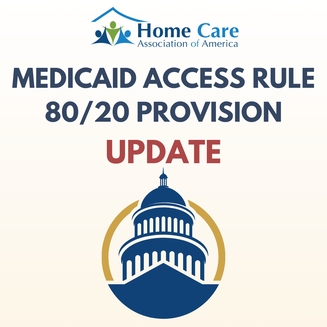
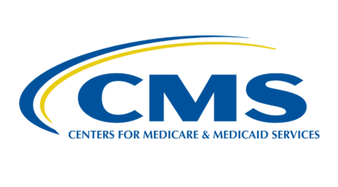

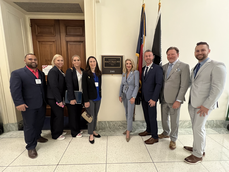
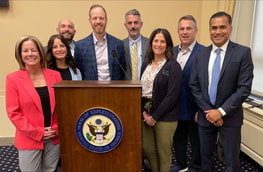

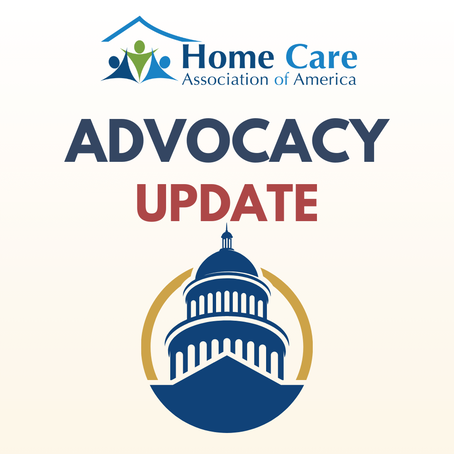
 RSS Feed
RSS Feed
